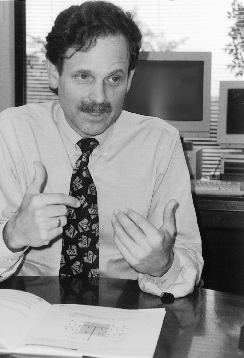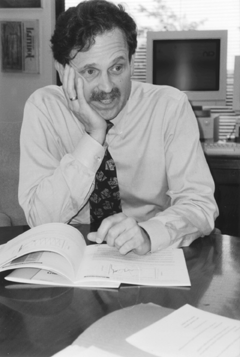


The Office of Technology Integration is one of three offices within the U.S. Department of Energy's Office of Science and Technology. Initiatives interviewed Mac Lankford, director of the Office of Technology Integration, on September 12, 1996 to learn how Technology Integration supports OST's mission.
It's apparent to anyone who spends a little time with Mac
Lankford that he loves his job. As director of the Office of
Technology Integration, Lankford is responsible for what he
describes as "all that other stuff that must be in place
before a technology can actually be used." As Lankford
explains it, OST does more than invest in the development and
demonstration of technologies. With the Office of Technology
Integration's help, OST also plans and puts into place
initiatives that increase the likelihood that promising
environmental technologies will be ready and actually selected to
clean up DOE sites. These initiatives recognize and deal with
nontechnical roadblocks that can crop up along a technology's
developmental path. By assisting technologies through potential pitfalls, the Office of
Technology Integration ensures that money OST invests in
developing innovative technologies is not wasted.
potential pitfalls, the Office of
Technology Integration ensures that money OST invests in
developing innovative technologies is not wasted.
Many elements of what OTI does are embodied in a "gate model" OST uses to decide whether a technology should continue to be funded. The Office of Technology Integration was instrumental in developing this model that makes explicit certain critical stages through which a technology must pass before more money is invested in its development. The model shows when and how financial, legal, regulatory, market, and stakeholder issues should kick in during development stages. The model employs gates to represent entry points into the next stage of development. Lankford offers the gate model as an example of the kind of good management tools the Office of Technology Integration is promoting throughout OST. By thinking of all parameters—both technical and nontechnical—and how they should be integrated, OTI is promoting strategic planning for technology development. Lankford said, "Completeness of thought is what this office is about. We're helping to change the culture in the focus areas, so all relevant issues are being covered in parallel."
For the gate model to be useful in assessing the viability of technologies at critical stages, all pertinent information must be gathered and made available to decision makers. During the next couple of months, OTI will be testing how well technical data and stakeholder and regulator feedback have been meaningfully documented to allow for good decisions. OTI will assess whether the information is available and presented in such a way that smart kill-or-continue decisions can be made about technologies.
Capturing useful data at the appropriate time is essential to make the model work and to persuade decision makers that better solutions do indeed exist to reduce cost, reduce risk, or do something that couldn't be done before. Among the focus area communication products supported by Lankford's office are the Innovative Technology Summary Reports, or Green Books (see Initiatives, August 1996). Lankford said the Green Books "came out of a need to capture data in such a way that all stakeholders, from users to regulators and local public interest groups, can know the technology is a better idea."
OTI uses other tools in addition to the Green Books to communicate the value of the OST program: newsletters, Technology Summary reports (also known as Rainbow Books), technology cards (see page 13), and Web sites, among others. Lankford believes these tools appeal to different audiences. "All these things are a portfolio, a full spectrum of tools for people to make better decisions."
A credible peer review system ensures that OST's technology development program is sound and its technologies have technical merit. Lankford said, "Our organization is arranging a major peer review system, so that the quality of our research and development program and our documents can be reviewed quickly and effectively by disinterested parties. By having neutral parties give us feedback, we have assurance we're effectively working on the right technology systems for the right kinds of problems."
OTI helps the focus areas answer the question, "Compared to a baseline technology, how much will this technology save the country if it is used at all sites where it has applicability?" For example, the cost of using an innovative technology to treat a single unit of a waste type is compared to the cost of treating that same amount and type of waste using a baseline technology. The difference is dramatic when that unit savings is multiplied by the known amounts of such waste at all known sites. Lankford credits Stan Wolf in OTI as the mastermind who has been working with focus areas to set the structure of cost analyses, treat all relevant costs consistently, and standardize cost reporting. Lankford said, "Stan's job is to help OST figure out which technology systems can have maximum impact on cost savings due to the technologies' applicability to high volumes of waste throughout the complex."

OTI helps private technology developers build business strategies and marketing plans so their technologies are attractive to investors and are commercially ready to be used to clean up DOE sites. From the stable of OST-funded technologies, OTI works with the focus areas to select those that have the greatest potential to clean up the largest portion of DOE environmental problems. To help these technologies Lankford calls "potential heavy hitters" compete, OTI has contracted with such entities as Global Environmental Technology Enterprise and Dawnbreaker. Dawnbreaker is a company that helps technology developers become more business savvy (see page 9). Lankford said, "To make a technology into a commercial win, Dawnbreaker works with a company on effective presentation skills. The company has to be willing to put in 300 to 1,000 hours or more of their own time to write the business plan well. Dawnbreaker will work with them on every sentence until their thinking is clarified, until the truth is captured."
In leveling the playing field for innovative technologies, OTI encourages DOE sites to write performance specification–based procurements that are technology neutral. Lankford said, "Sites shouldn't be able to preclude a better solution by making a statement on the technology to be used." Instead, Lankford said procurements should specify the level of cleanliness a technology must achieve to be considered for a cleanup project.
Stakeholder involvement is also an essential part of "all that other stuff" that OTI plans for and coordinates. By sowing seeds early with stakeholders, OTI increases the likelihood a technology will enjoy support and acceptance as it travels its path toward full development and commercialization. In Lankford's view, stakeholders "need to have ownership of the solution, and the ownership is developed by participation in our program. We're really looking for a co-design of the program."
Lankford talked about the evolution of the Community Leaders Network.
"CLN sprang from a sense we needed to be talking with the
public, but we didn't have a clue about a good way to do
that." Eventually, an idea was born to bring together the
managers of the focus areas with CLN participants. "It
turned out many CLN participants were interested in specific
focus areas." So, subgroups within CLN were formed for more
effective interaction between focus areas and CLN participants.
Lankford is pleased focus area people understand how stakeholder
interest and participation  enrich
the technology development program. Lankford said, "I think the perception
is that stakeholders are not a hoop you've got to jump through;
they're a real value added."
enrich
the technology development program. Lankford said, "I think the perception
is that stakeholders are not a hoop you've got to jump through;
they're a real value added."
Lankford talked about the role OTI plays in bringing together the 22-state Interstate Technology Regulatory Cooperation Working Group. To date, regulators from six states have agreed by a Memorandum of Understanding to become partners in promoting cooperative approval and permitting of innovative environmental technologies. The MOU member states are California, Illinois, Massachusetts, New Jersey, New York, and Pennsylvania. Lankford said OTI simply provides the funds to make it possible for the group to meet and work on reciprocal protocols. The states provide their own momentum; because, Lankford said, the group "loves working together. We just keep it going; we don't control the meetings." They set their own agenda, although OTI may suggest technology areas on which broad regulatory approvals are needed.
Lankford pointed out the significance to a private company of having its technology data jointly accepted by six states at once as opposed to the expense of gaining acceptance state by state. "This is fantastic, because what it does for a private company and its investors is open the market up without having to run the same tests and procedures over and over again in each state." Lankford believes more states and regions will join the initiative, and even more opportunities will be opened for technology developers and marketers. In October, Vice President Al Gore recognized this initiative by presenting Hammer Awards to OST's Deputy Assistant Clyde Frank and participating states (see page 1).
Lankford said, "We not only integrate our program internally so all tools are ready to get technologies implemented, but we also integrate externally with other federal and international agencies." OTI seeks to share technologies to meet common needs and find international markets for OST-developed technologies. In facilitating collaborative research and activities with other countries, OTI may provide market analyses, arrange cooperative agreements, make money transfers, provide for international travel, or provide interpreters.
Working all the angles to get innovative environmental technologies used includes building credible budgets, establishing good business practices, and monitoring the program's execution. OTI participates by doing business planning, coordinating input from the offices within OST, and producing briefing packages and budget narratives to explain budget requests to Congress. During the year when the budget is being spent, OTI is responsible for helping OST control costs, manage schedules, and ensure that work covered by the budget is getting accomplished.
In getting OST's technologies implemented, Lankford emphasizes a whole team approach. According to Lankford, "A technology will not ultimately be used in the cleanup of the DOE complex unless all relevant issues are integrated and handled in parallel. It is not the Office of Technology Integration that will accomplish this. The focus areas must take the lead in getting their systems used. OTI has the tools to help the focus areas accomplish their goals."
Because Lankford believes it is the people in his office that make it tick, he asked that the following people be recognized for their contributions to the Office of Technology Integration.
|
All photos by Judy Schwab
![]()
![]()
![]()